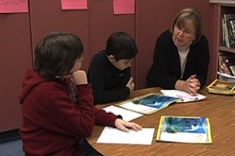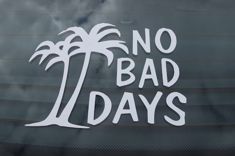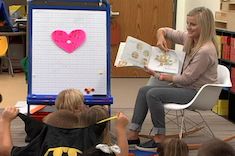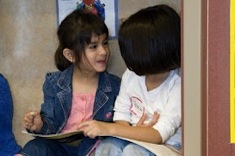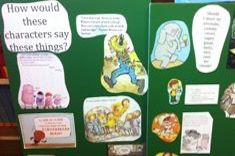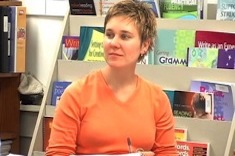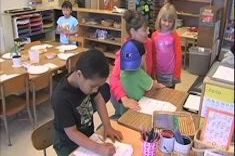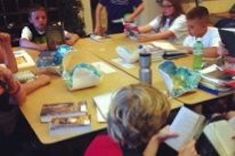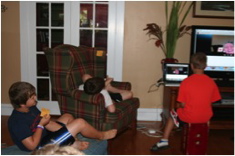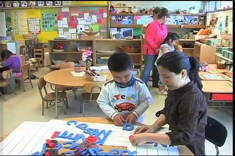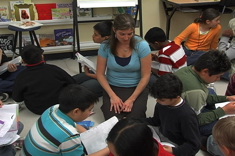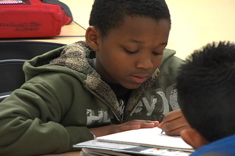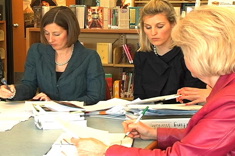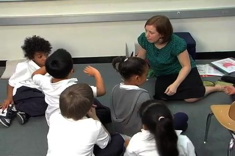Community Building
It's one of the big paradoxes of literacy instruction - students best learn how to read and write independently when they have a strong community of support in classrooms. How teachers build those thoughtful, kind, and challenging classroom communities is explained in these resources.
Latest Content
Opening Doors to Parents in Middle School
Gretchen Taylor finds middle school parents enjoy hearing about their child’s day — it’s just a matter of getting creative in dealing with the large number of families.
Book Memories
Jennifer Schwanke finds connections between her childhood, teaching, and school leadership in this heartwarming essay.
Trust
Mary Lee Hahn reminds herself (and us!) of the qualities we have that inspire trust in ourselves and our ability to teach well.
Do They Care? Empathy Book Clubs
Do they care? That’s the question Karen Terlecky asks herself as she sets up book clubs in her fifth-grade classroom with a focus on empathy.
The Power of Music
What can music add to the classroom? Plenty! Sean Moore and Heather Rader provide many examples and favorite tunes.
Notes from the Mad Teachers Liberation Front: Create Your Manifesto
Start your school year off right (or get it back on track) with a manifesto about who you are and what you value. Ruth Shagoury provides a mentor poem, guidelines and samples.
Field Experience: Social-Emotional Learning in Workshop
Compassion and understanding are as important to workshop instruction as strategies and routines. Ruth Ayres compiled a field experience to highlight the way understanding the social-emotional needs of students (and ourselves) allows for safe learning environments.
A Perfect Storm
If you work with young children, you know these girls. Olivia is a pink princess, given to tears and fanciful tales of slights from classmates. Maggie is a tomboy who struts around in zombie t-shirts and doesn’t suffer fools gladly. The two meet like gladiators in the preschool playhouse late in the school year.
Walls, Displays, and Invitations Early in the School Year
Franki Sibberson turns to museums for inspiration as she designs wall displays for the start of the school year.
Reaching Evan with Read Alouds in the Intermediate Grades
Karen Terlecky reflects on the power of read alouds in the intermediate grades for welcoming older students who struggle with reading into the “club” of kids who love books.
One Book, One School: Building Community with Shared Text
"When given the choice between being right or being kind, choose kind." These words from the book Wonder set Katherine Sokolowski on the path of designing a shared reading experience at her school that will build community and empathy across the grades.
Loops and Blended Classrooms: Practical Tips to Start the School Year
It can feel like “old home week” when you have students returning to your classroom for a second year. But blending and looping both present their own special challenges during the first days of school. Melanie Quinn has advice for getting the year off to a good start.
Discussing Observations with New Teachers
Jennifer Allen’s new teacher group discusses what they learn from classroom observations in this video taped early in the fall.
The Quest for the Perfect First Read Aloud of the Year
Franki Sibberson is on a quest to find the perfect first read aloud of the year, and the search helps her consider the goals and purpose of read alouds during the first days of school.
Preschool Morning Sign-In
Melissa Kolb explains the social and academic value of morning sign-in for preschoolers.
Making Thinking Visible
A class blog proves to be a surprisingly successful tool for building academic connections within and across classrooms of Gretchen Taylor’s middle school students.
Ask Me – I’m Not the Expert
Heather Sisson explores the complicated links between relationships and expertise for literacy coaches and teachers.
Making the Switch from Desks to Tables
Moving from desks to tables when redesigning a classroom is about a whole lot more than just furniture. Katherine Sokolowski explains what the change has meant to her classroom.
Don’t Be a Sneetch
Amanda Adrian ponders end-of-year celebrations, as well as the haves and have-nots, in schools.
An At-Home Summer Reading Camp
Katherine Sokolowski comes up with a novel way to boost kids’ reading and her summer income —hosting a reading camp in her home.
What to Say on Parent Teacher Night
Clare Landrigan and Tammy Mulligan present some of the anecdotes and research they would share with parents during open houses and conferences.
Connecting Read Alouds and the Literacy Curriculum at the Start of the School Year
Here are some ways to link read alouds with learning across the curriculum at the start of the year, suggested by Choice Literacy readers.
11/11/11: We Are One Celebration with Amy Krouse Rosenthal
Hundreds of people gathered at Millennium Park in Chicago for a joyful and silly celebration of Amy Krouse Rosenthal’s “We Are One” flash mob.
Preschool Centers
Centers can be an effective teaching and learning strategy in preschools. In this video, Melissa Kolb shares her rationale for using centers in her Head Start classroom with video examples of centers.
Every. Single. Day.
Ruth Shagoury listens in as Katie Doherty's students give advice to a new classmate, and in the process reveal the norms and expectations for reading and writing workshops.
“School” Writing at the End of the Year
Writing about education is important in Erin Ocon's middle school classroom. Although Erin's students are in the eighth grade, this is a terrific project for readers of any age, and could even be used schoolwide for closure and celebration.
Building Community Protocols
Clare Landrigan and Tammy Mulligan share two of their favorite protocols for building community among educators.
Status of the Class and Monitoring Behavior
In this early year video from Beth Lawson’s second-grade classroom, Beth uses a writing status-of-the-class time to help students monitor their behavior, using peers as role models.
The Power of Games for 21st Century Learners
Franki Sibberson explains how low-tech board games can be a powerful tool for developing skills that will be in high demand in the coming years.
Making Kids Aware of Their Thinking
If we stopped every time a child was thinking, wondering or connecting to our read aloud, we’d lose the continuity of the writing. Jennifer McDonough teaches students gestures to give her feedback about when and how kids are thinking.
Browse Content By
Type
Category
- Assessment Tools
- Big Fresh Archives
- Booklists
- Choice Numeracy
- Classroom Design
- Common Core
- Community Building
- Conferring
- Content Literacy
- Digital Literacy
- English Language Learners
- Equity
- Family Relations
- Free Samples
- Guiding Groups
- Leadership
- Literacy Coaches
- Mentor Texts
- Minilessons
- New Teacher Mentors
- Podcasts
- Poetry
- Quote Collections
- Reading Strategies
- Self Care
- Struggling and Striving Learners
- Talking and Listening
- Teacher Study Groups
- Teaching Reading
- Teaching Writing
- Word Study and Vocabulary
Author
- Melissa Quimby
- Nawal Qarooni
- Gwen Blumberg
- Julie Cox
- The Lead Learners
- Hannah Tills
- Josie Stewart
- Ruth Metcalfe
- Mallory Messenger
- Becca Burk
- Jodie Bailey
- Vivian Chen
- Mary Brower
- Tiffany Abbott Fuller
- Stephanie Affinito
- Ruth Ayres
- Leigh Anne Eck
- Heather Fisher
- Shari Frost
- Julie Johnson
- Suzy Kaback
- Gigi McAllister
- Shirl McPhillips
- Melanie Meehan
- Cathy Mere
- Debbie Miller
- Tara Barnett and Kate Mills
- Tammy Mulligan
- Dana Murphy
- Bitsy Parks
- David Pittman
- Brenda Power
- Heather Rader
- Matt Renwick
- Mandy Robek
- Christy Rush-Levine
- Gretchen Schroeder
- Jen Schwanke
- Brian Sepe
- Katherine Sokolowski
- Stella Villalba
- Jennifer Vincent
Grade Level
Choice Literacy Membership
Articles
Get full access to all Choice Literacy article content
Videos
Get full access to all Choice Literacy video content
Courses
Access Choice Literacy course curriculum and training




